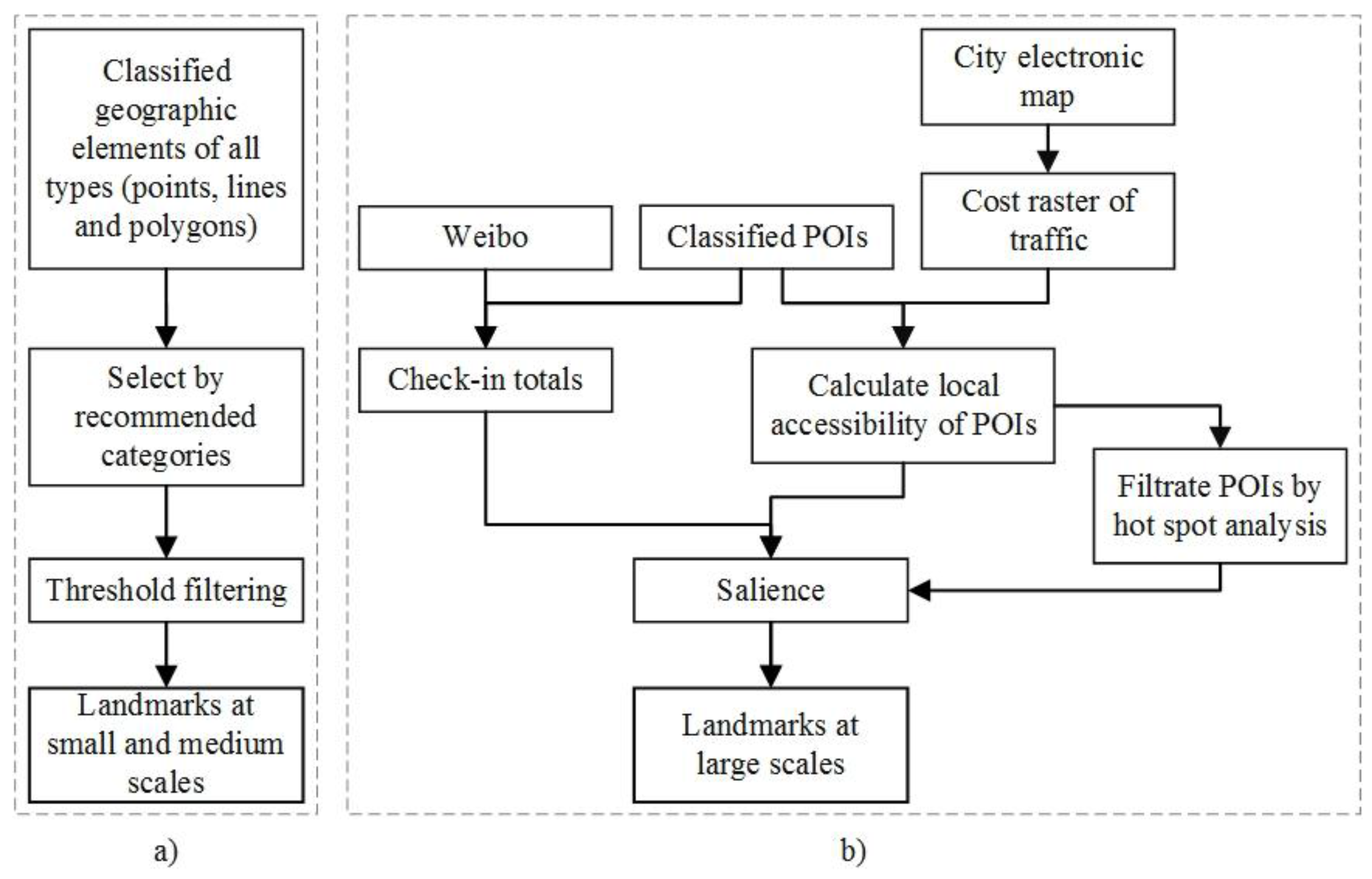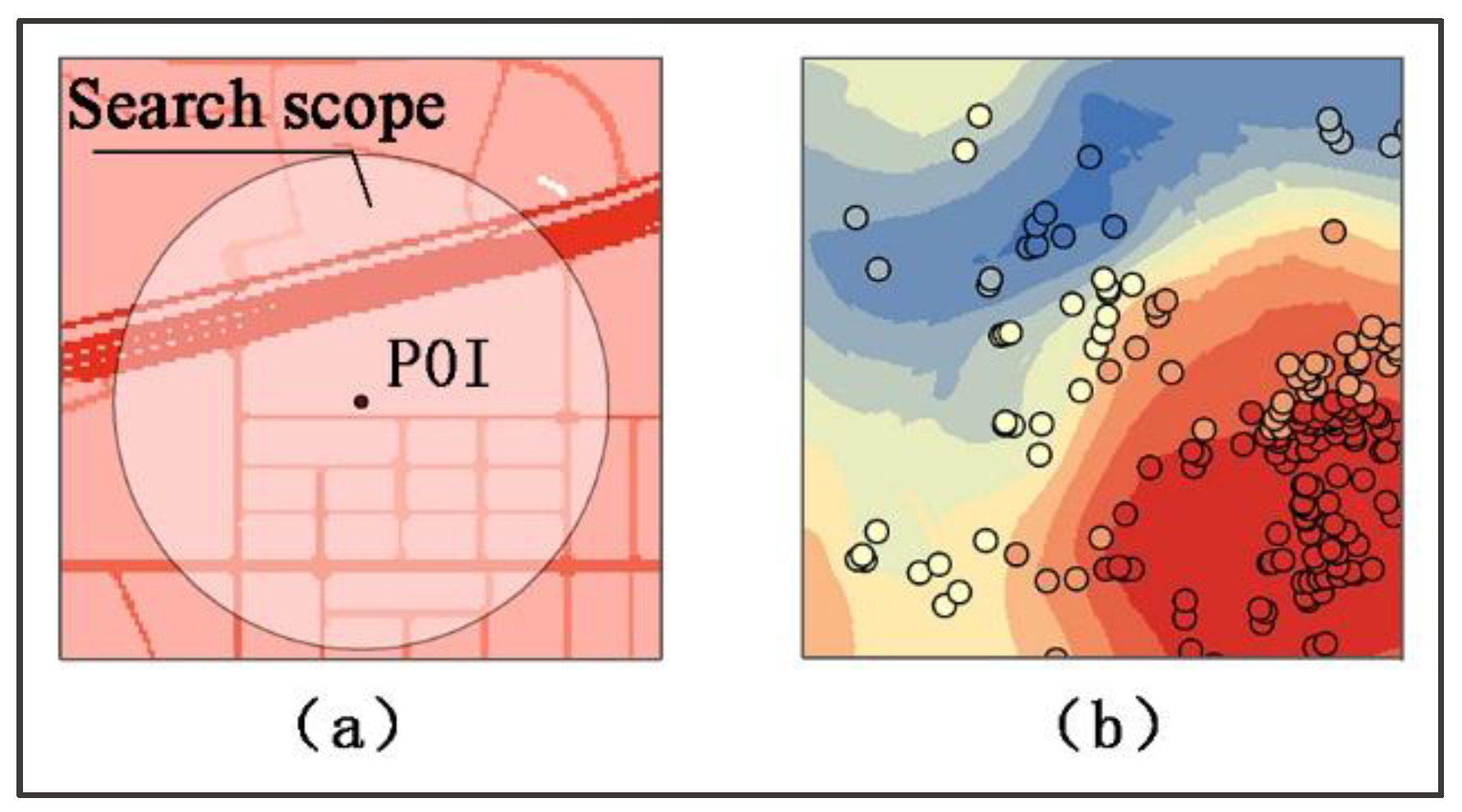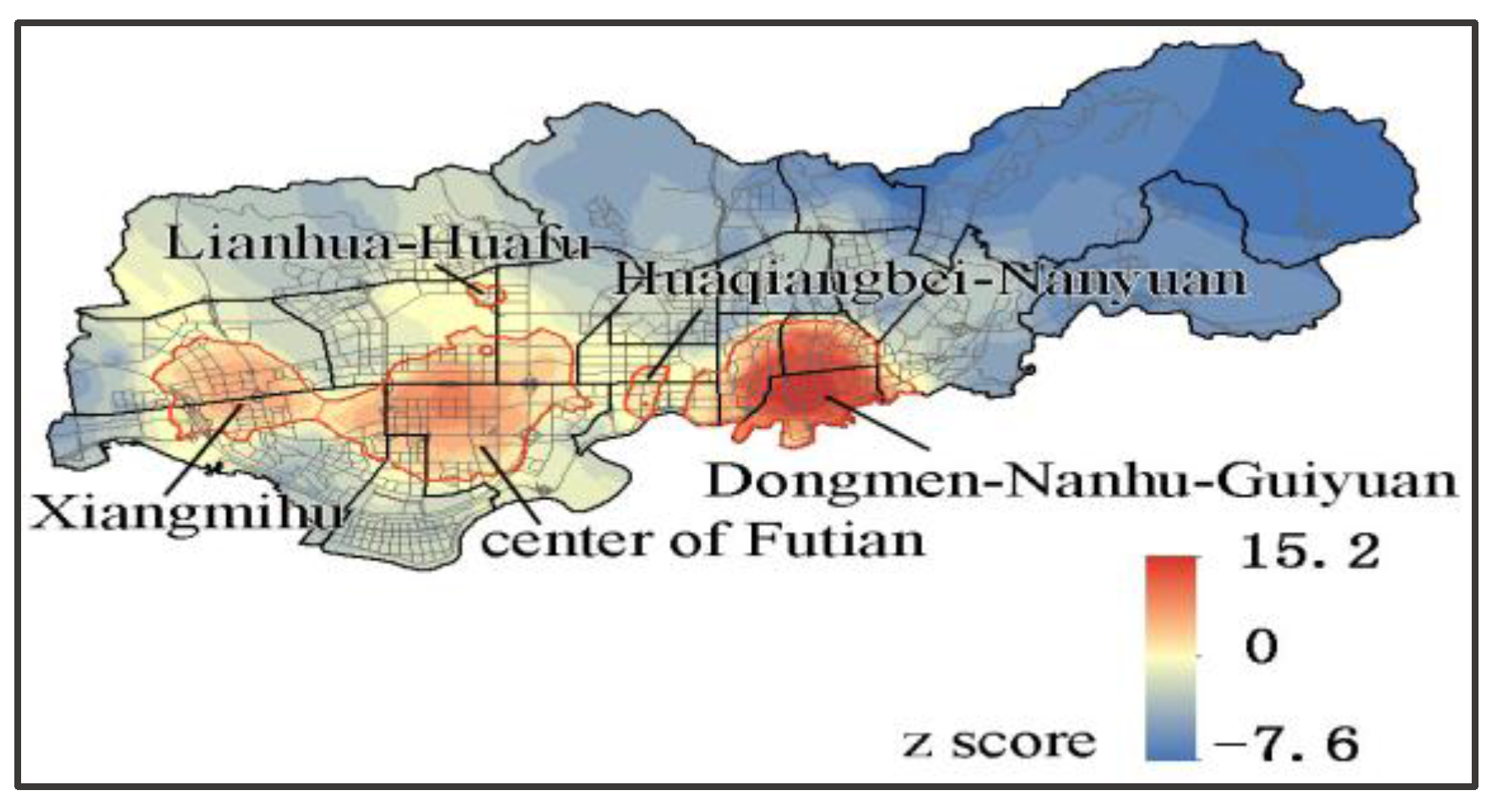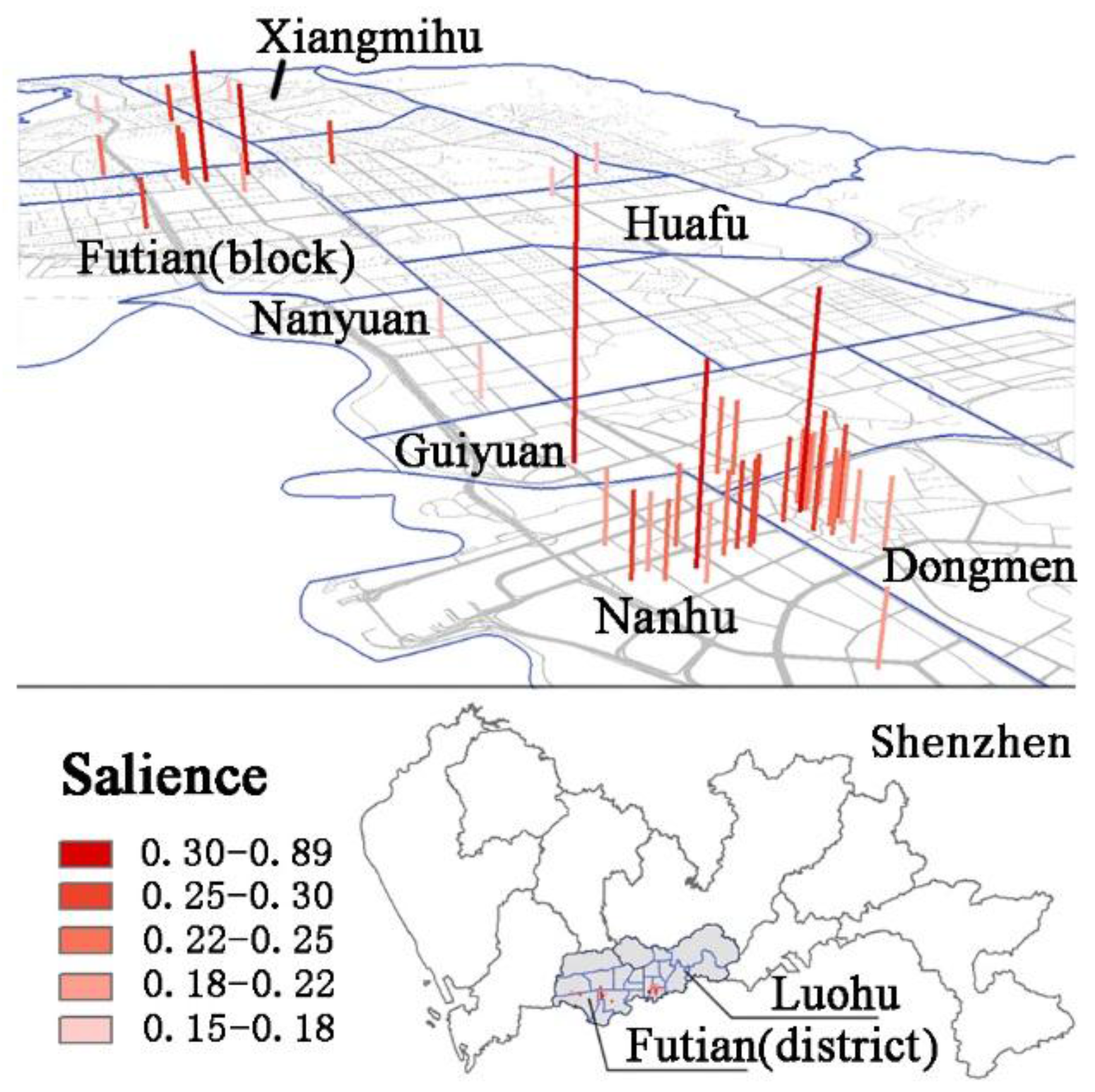Salience Indicators for Landmark Extraction at Large Spatial Scales Based on Spatial Analysis Methods
Abstract
:1. Introduction
2. Related Works
2.1. Evaluation and Extraction Methods for Landmarks
2.2. Landmark Hierarchies
3. Definitions for Landmarks at Multiple Scales
3.1. Landmarks at Small Scales
- Their names are unique in the entire city.
- Perceptually, they have obvious spatial boundaries, cover a large area, or act as dividing features for the urban regional structure.
- Cognitively, they play important roles as transportation, cultural or political hubs both within the city and to the outside world; both inhabitants and travelers are highly aware of these landmarks, and these features can help identify the global spatial structures of the city.
- Contextually, they can act as route guidelines or destinations for a trip; thus, they are always salient in a travel context.
3.2. Landmarks at Medium Scales
- Their names are unique within the region/district.
- Perceptually, they cover a certain area or divide the region/district.
- Cognitively, they provide large public venues for social, economic, cultural, political, and recreational activities, and inhabitants are highly aware of them.
- Contextually, they have an extensible form that radially influences the surrounding features, can provide topological guidance, or are near decision points (such as intersections), and they are usually salient in driving or riding contexts.
3.3. Landmarks at Large Scales
- Perceptually, they are close to roads and are easily accessible.
- Cognitively, they provide venues (public service facilities) where people participate in social, economic, cultural, political, and recreational activities, have cultural (memorial) value, or are transportation facilities. They are intimately related to peoples’ daily lives, and nearby residents are highly aware of them.
- Contextually, they are usually near roads and salient in a walking context.
4. Landmark Extraction
4.1. Landmark Extraction at Multiple Scales
4.2. Landmark Extraction at Large Scales
- (1)
- Appearance indices are difficult to obtain. When the number of spatial features becomes large, these indices become difficult to obtain and measure, making them impractical for assessing landmark salience. In other researches, for examples, Raubal and Winter use visual, semantic and structural attraction to assess salience of landmarks. The data sources they need include digital city maps, navigation graphs, and rectified geo-referenced images of facades [1], in which the images are not available according to our database. The data source Elias used are buildings in cadastral data set [19,25], in which parcel information is not available either in our basic geographic information database.
- (2)
- Perceptual saliency will partly transition into cognitive saliency after a period, because spatial cognition usually begins with perception. There are several theoretical perspectives or frameworks that have described the process of spatial cognition developing [26].The process of human spatial cognition, usually starts with perception, such as the process of perception, coding, saving, memorizing and decoding, and then become cognition [27].
4.2.1. Check-in Totals
4.2.2. Local Accessibility
4.2.3. Salience
4.3. Entire Extraction Method
5. Study Area and Data Sources
6. Results and Discussion
- Filtering landmarks by hot spot regions of local accessibility omitted some potential landmarks with high check-in totals and may not have been suitable to some evenly scattered facilities. For instance, some shopping malls with very large areas, such as the KK Mall, had corresponding POIs at the center of the building, far from roads. Another instance involved evenly scattered gas stations. These features were not clustered with other POIs and thus were not located in hot spot regions with high local accessibility; therefore, despite their high check-in totals, these locations were not extracted as landmarks.
- The landmarks that were extracted by this method were relatively over-concentrated (Figure 6) compared to the reference landmarks. The landmarks that we extracted were mostly grouped in the Dongmen and Nanhu sub-districts because of the large numbers of POIs in these areas. After extracting landmarks from each cluster at the same percentage rate (20%), the landmarks that were selected from these areas still formed a large number. This phenomenon of landmark concentration can be explained by inhomogeneity and subjectivity [34]. Although this result conforms to the representation of spatial knowledge, it is not beneficial for practical landmark extraction in fields such as navigation.
- The extraction results conformed better to the cognition of young people than to the cognition of others. Because of the bias of check-in data, POIs with high check-in totals were usually shopping malls that young people frequent, which increased the probability of these POIs being extracted as landmarks.
7. Conclusions
7.1. Main Contributions
- A systematic definition for landmarks at multi-scales from the perspective of representation of spatial knowledge
- A category reference for landmarks extraction at small- and medium-scales
- Salience indicators and extraction methods for landmarks at large scale, based on basic geographic information databases
7.2. Future Work
- Detailed threshold limits for landmarks extraction at small- and medium-scales are needed in future work, including threshold limits for each category, and also for different city size or under other special circumstances
- Other salience indicators to be added, such as geometric indicators
Acknowledgments
Author Contributions
Conflicts of Interest
References
- Sorrows, M.E.; Hirtle, S.C. The nature of landmarks for real and electronic spaces spatial information theory. In Cognitive and Computational Foundations of Geographic Information Science; Springer: Berlin/Heidelberg, Germany, 1999; pp. 37–50. [Google Scholar]
- Lynch, K. The image of the city. J. Aesthet. Art Crit. 1960, 24, 46–68. [Google Scholar]
- Raubal, M.; Winter, S. Enriching wayfinding instructions with local landmarks. Geogr. Inf. Sci. 2002, 2478, 234–259. [Google Scholar]
- Winter, S.; Tomko, M.; Elias, B.; Sester, M. Landmark hierarchies in context. Envir. Plan. B Plan. Des. 2008, 35, 381. [Google Scholar] [CrossRef]
- Presson, C.C.; Montello, D.R. Points of reference in spatial cognition: Stalking the elusive landmark. Br. J. Dev. Psychol. 1988, 6, 378–381. [Google Scholar] [CrossRef]
- Zhang, X.; Li, Q.; Fang, Z. An approach of generating landmark chain for pedestrian navigation applications. Geomat. Inf. Sci. Wuhan Univ. 2010, 35, 1240–1244. [Google Scholar]
- Michon, P.E.; Denis, M. When and Why Are Visual Landmarks Used in Giving Directions? Springer: Berlin/Heidelber, Germany, 2001. [Google Scholar]
- Golledge, R.G. Human Wayfinding and Cognitive Maps; Johns Hopkins University Press: Baltimore, MD, USA, 1999; pp. 5–45. [Google Scholar]
- Deakin, A.K. Landmarks as navigational aids on street maps. Cartogr. Geogr. Inf. Sci. 1996, 23, 21–36. [Google Scholar] [CrossRef]
- Tomko, M.; Winter, S. Pragmatic construction of destination descriptions for urban environments. Spat. Cognit. Comput. 2009, 9, 1–29. [Google Scholar] [CrossRef] [Green Version]
- Klippel, A.; Winter, S. Structural salience of landmarks for route directions. Comput. Sci. 2005, 33, 347–362. [Google Scholar]
- Nothegger, C.; Winter, S.; Raubal, M. Selection of salient features for route directions. Spat. Cognit. Comput. 2004, 4, 113–136. [Google Scholar] [CrossRef]
- Haken, H.; Portugali, J. The face of the city is its information. J. Environ. Psychol. 2003, 23, 385–408. [Google Scholar] [CrossRef]
- Caduff, D.; Timpf, S. On the assessment of landmark salience for human navigation. Cognit. Process. 2008, 9, 249–267. [Google Scholar] [CrossRef] [PubMed]
- Wang, M.; Hu, Q.; Li, Q.; Qin, L. Extracting hierarchical landmark from check-in data. Chin. J. Comput. 2016, 39, 405–413. [Google Scholar]
- Li, L.; Mao, K.; Tan, Y. Hierarchy landmarks multi-granularity description method for route guidance. Acta Geod. Cartogr. Sin. 2014, 43, 105–112. [Google Scholar]
- Fang, Z.; Li, Q.; Zhang, X.; Shaw, S.L. A GIS data model for landmark-based pedestrian navigation. Int. J. Geogr. Inf. Sci. 2012, 26, 817–838. [Google Scholar] [CrossRef]
- Zhao, W.; Li, Q.; Li, B. Extracting hierarchical landmarks from urban POI data. J. Remote Sens. 2011, 15, 973–988. [Google Scholar]
- Elias, B. Extracting landmarks with data mining methods. Lect. Notes Comput. Sci. 2003, 2825, 375–389. [Google Scholar]
- Tezuka, T.; Tanaka, K. Landmark extraction: A web mining approach. In Spatial Information Theory; Springer: Berlin/Heidelberg, Germany, 2005; pp. 379–396. [Google Scholar]
- Joan, S.; Vidal-Calleja, T.; Civera, J.; Montiel, J.; Montiel, J.M.M. Impact of landmark parametrization on monocular EKF-SLAM with points and lines. Int. J. Comput. Vis. 2012, 97, 339–368. [Google Scholar]
- Lovelace, K.L.; Hegarty, M.; Montello, D.R. Elements of Good Route Directions in Familiar and Unfamiliar Environments; Springer: Berlin/Heidelberg, Germany, 1999. [Google Scholar]
- Ai, T.; Cheng, J. Key issues of multi-scale representation of spatial data. Geomat. Inf. Sci. Wuhan Univ. 2005, 30, 377–382. [Google Scholar]
- AQSIQ. Specifications for Feature Classification and Codes of Fundamental Geographic Information; Standards Press of China: Beijing, China, 2005; Volume GB/T 13923-2006. [Google Scholar]
- Elias, B.; Brenner, C. Automatic Generation and Application of Landmarks in Navigation Data Sets; Springer: Berlin/Heidelberg, Germany, 2005. [Google Scholar]
- Montello, D.R. Cognition of Geographic Information; CRC Press: Duluth, MN, USA, 2005; Volume 4, pp. 61–91. [Google Scholar]
- Lloyd, R. Spatial Cognition: Geographic Environments; Kluwer Academic Pulishers: Dordrecht, The Netherlands, 1997. [Google Scholar]
- MOHURD. Code for Design of Urban Road Engineering; China Architecture & Building Press: Beijing, China, 2012; Volume CJJ 37-2012. [Google Scholar]
- Getis, A.; Ord, J.K. The analysis of spatial association by use of distance statistics. Geogr. Anal. 1992, 24, 189–206. [Google Scholar] [CrossRef]
- Wang, M.J.; Zhang, X.X.; Huo, T.T. Spatial correlation patterns of sites cognition rate in Beijing. Acta Geogr. Sin. 2009, 64, 1243–1254. [Google Scholar]
- Shannon, C.E. A Mathematical Theory of Communication; University of Illinois Press: Champaign, IL, USA, 1948; Volume 5, pp. 3–55. [Google Scholar]
- Yicheng, Y. Technology and Application of Comprehensive Evaluation System; Metallurgical Industry Press: Beijing, China, 2006. [Google Scholar]
- Qi, Y.; Wen, F.; Wang, K.; Li, L.; Singh, S. A fuzzy comprehensive evaluation and entropy weight decision-making based method for power network structure assessment. Int. J. Eng. Sci. Technol. 2010, 2, 92–99. [Google Scholar] [CrossRef]
- Ai, T. Maps adaptable to represent spatial cognition. J. Remote Sens. 2008, 12, 22. [Google Scholar]






| Feature Code | Category | Salience Introduction |
|---|---|---|
| 210101/220100/230101/240101 | Rivers/canals/lakes/reservoirs (large scale) | Perceptually salient because of their appearance. Cognitively salient because of their effect on climate, traffic and culture; well-known among inhabitants and travelers. Can derive toponyms, contextually salient in address descriptions. |
| 350000/670101 | Places of interest/ nature or culture reserves (national) | Perceptually salient because of their appearance, voice, smell, etc. Cognitively salient because of their natural or cultural significance; well-known among locals and travelers. Contextually salient in sightseeing. |
| 410301 | Train stations | Perceptually salient because of their appearance. Cognitively salient because of their significance in travel experience. Contextually salient in traveling by train, car and bicycle. |
| 480100 | Airports | Perceptually salient because of their appearance. Cognitively salient because of their significance in travel experience. Contextually salient in traveling by plane. |
| 650100 | Administrative areas (district/county) | Cognitively salient in common sense. Can be toponyms, contextually salient in address descriptions. |
| 750101/750900 | Peaks/snow-capped mountains | Perceptually salient because of appearance and landscape. Cognitively salient because of their effect on climate, traffic and culture; well-known among inhabitants and travelers. Can derive toponyms, contextually salient in address descriptions. |
| Feature Code | Category | Salience Introduction |
|---|---|---|
| 340101 | Schools (universities) | Perceptually salient in appearance. Cognitively salient in educational experiences among inhabitants. Contextually salient in sightseeing and driving context. |
| 340102 | Hospitals (polyclinic) | Perceptually salient in appearance. Cognitively salient in seeking medical service experiences. Contextually salient in driving context. |
| 340201 | Hotels (star-rated hotels) | Perceptually salient in appearance. Cognitively salient in tourism experiences. Contextually salient in driving context. |
| 340301 | Amusement parks (large scale) | Perceptually salient in appearance. Cognitively salient in recreational experiences. Contextually salient in sightseeing and driving context. |
| 340302 | Parks (multifunction parks) | Perceptually salient in appearance and landscape. Cognitively salient in recreational experiences. Contextually salient in sightseeing and driving context. |
| 340303/340304 | Zoos/arboretum | Perceptually salient in appearance. Cognitively salient in recreational experiences. Contextually salient in sightseeing and driving context. |
| 340401 | Stadium (large scale) | Perceptually salient in appearance. Cognitively salient in sports and leisure experiences. Contextually salient in driving context. |
| 340501 | TV station (provincial level) | Perceptually salient in appearance. Cognitively salient because of their significance in media. Contextually salient in sightseeing and driving context. |
| 340701 | Cemetery (large scale) | Perceptually salient in appearance. Cognitively salient in living experiences. Contextually salient in driving context. |
| 430300 | Viaduct | Perceptually salient in appearance (higher elevations than other roads and usually no traffic lights). Cognitively salient in travelling experiences. Contextually salient in driving context. |
| 430501 | Trunk roads | Perceptually salient in appearance (generally wider than other roads). Cognitively salient in travelling experiences. Contextually salient in driving context. |
| 660100 | Administrative areas (towns) | Divide urban areas, cognitively salient in common sense. Can derive toponyms, contextually salient in address description, frequently mentioned in way-finding. |
| Category | Speed (km/h) | Transport Capacity | Travel-Time Cost (Minutes) |
|---|---|---|---|
| Superhighway | 100 | 1 | 0.008 |
| Subway | 30~80 | 6 | 0.004 |
| Expressway | 60 | 5 | 0.0045 |
| Trunk Road | 50 | 4 | 0.006 |
| Sub-trunk road | 40 | 3 | 0.0075 |
| Branch road | 30 | 2 | 0.01 |
| Interior road | 10 | 1.5 | 0.03 |
| Ground | 5 | 1 | 0.06 |
| Buildings & vegetation | 5 | 1 | 0.06 |
| Water | Impassable | 0 | Null |
| Hot Spot Regions | Rank | POI Names | Check-in Totals | Local Accessibility | Salience |
|---|---|---|---|---|---|
| Dongmen-Nanhu-Guiyuan region | 1 | The MIXC | 35,860 | 19.8507 | 0.8886 |
| 2 | DongMenTing Shopping Plaza | 20,206 | 20.6248 | 0.6289 | |
| 3 | Jinguanghua Square | 16,582 | 20.4516 | 0.5479 | |
| 4 | Taiyang Department Store | 3654 | 20.3044 | 0.2868 | |
| 5 | Tianhong Department Store | 105 | 20.2042 | 0.2676 | |
| 6 | Guomao Department Store | 65 | 20.8004 | 0.2494 | |
| 7 | Shenfang Department Store | 0 | 20.8067 | 0.2453 | |
| 8 | Nantang Department Store | 652 | 20.5659 | 0.2437 | |
| 9 | Maoye Department Store | 1638 | 20.2362 | 0.2434 | |
| Central Futian region | 1 | COCO Park (center 2 road shop) | 21,928 | 21.2092 | 0.6971 |
| 2 | Chengjian Shopping Mall | 12,419 | 21.0220 | 0.5004 | |
| 3 | Tianhong Shopping Mall | 20 | 21.3766 | 0.2794 | |
| Xiangmihu region | 1 | Guohuilkang Department Store (Tairan 4 road shop) | 6 | 20.7735 | 0.2434 |
| 2 | Jiajiafu Shopping Mall | 0 | 20.0438 | 0.2000 | |
| Other regions | 1 | Baijia Global Shop | 0 | 20.9530 | 0.2465 |
| 2 | Suibao Department Store | 34 | 19.9233 | 0.1822 | |
| 3 | Minrun Shopping Mall (Lianhua branch road shop) | 0 | 19.6071 | 0.1742 | |
| 4 | Nanyuan Department Store | 0 | 19.4066 | 0.1623 |
© 2017 by the authors. Licensee MDPI, Basel, Switzerland. This article is an open access article distributed under the terms and conditions of the Creative Commons Attribution (CC BY) license ( http://creativecommons.org/licenses/by/4.0/).
Share and Cite
Weng, M.; Xiong, Q.; Kang, M. Salience Indicators for Landmark Extraction at Large Spatial Scales Based on Spatial Analysis Methods. ISPRS Int. J. Geo-Inf. 2017, 6, 72. https://doi.org/10.3390/ijgi6030072
Weng M, Xiong Q, Kang M. Salience Indicators for Landmark Extraction at Large Spatial Scales Based on Spatial Analysis Methods. ISPRS International Journal of Geo-Information. 2017; 6(3):72. https://doi.org/10.3390/ijgi6030072
Chicago/Turabian StyleWeng, Min, Qin Xiong, and Mengjun Kang. 2017. "Salience Indicators for Landmark Extraction at Large Spatial Scales Based on Spatial Analysis Methods" ISPRS International Journal of Geo-Information 6, no. 3: 72. https://doi.org/10.3390/ijgi6030072
APA StyleWeng, M., Xiong, Q., & Kang, M. (2017). Salience Indicators for Landmark Extraction at Large Spatial Scales Based on Spatial Analysis Methods. ISPRS International Journal of Geo-Information, 6(3), 72. https://doi.org/10.3390/ijgi6030072








